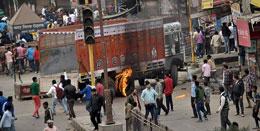Jat revolution in India

Square-jawed, cleft chin and hair untidily spiked, Vikas Thakaran glowered as he explained why he was here in this scrum of young men blocking Bakhtawar chowk, 30km southwest of India’s capital, part of a violent weeklong agitation that has left 12 dead, vehicles and railway stations burnt, and the army deployed.
Thakaran, 24, is a computer-science engineer, but he is unemployed. “I applied for government jobs four-five times, many times elsewhere, but I didn’t get through,” he said.
There are many educated, angry and unemployed young men like Thakaran, or those unable to find a job commensurate with their aspirations and education, among the thousands of protesters from a caste group that many say has no reason to protest.
Traditional landowners, the Jats are a powerful Hindu caste now demanding classification as a “backward” caste — a contention rejected last year by the Supreme Court — so that government jobs can be reserved for them.
However, an IndiaSpend analysis of employment data and evaluation of aspirations of young Jats revealed that the protests are manifestations of India’s slow, inadequate job-creation and a failing education system creating thousands of “unemployable” graduates.
This disconnect between education, aspirations and jobs explains similar demands to be classified as “backward” and “other-backward-caste (OBC)” by socially powerful caste groups — Gujjars (Rajasthan), Marathas (Maharashtra), Patels (Gujarat) and Kapus (Andhra Pradesh), among others — struggling to find satisfactory employment.
Organised industry added 500,000 jobs in 2014. India needs more than a million a month.
Saurabh Rangi, 24, a native of Rohtak city, scored 75 per cent in the All India Engineering Entrance Exam (AIEEE), but he is on the streets of Haryana’s Gurgaon city — 30km northwest of Delhi-because he did not get admission to a government college and had to pay “lakhs” of rupees to graduate from a private college. Range is angry; he holds a public-relations trainee job at cardekho.com, an automobile website, but wants a government job.
“I got a BTech in 2013, but I am unemployed even after two years,” said Keshav Lather, as he protested in Gohana, Sonipat, 43km west of Rohtak. “I have applied for a Central government job. But I always lose out because of reservation…a professional education does not necessarily mean a good job. We were surprised at the type of jobs and money offered to many of our friends.”
Labourers, guards and maids form the majority of the jobs available to more than a million Indians — some estimate it is nearly two million — who join the workforce every month. Over 30 years, India generated no more than seven million jobs every year, with only a fraction being the kinds of jobs the young Jats desire.
This is why protesters across India demand secure government jobs; it is why engineers and doctors throng job openings for peons, clerks and constables (as they did in Uttar Pradesh last year, when 2.3 million applied for 368 positions of peons).
As we also reported, new employment data indicate two disquieting trends.
One, a slowdown in employment in the formal, organised sector (which in any case employs only 12 per cent of India’s labour force), the prime staging ground of Prime Minister Narendra Modi’s Make in India programme. In Indian factories, more than 400,000 people lost their jobs during the financial year 2012-13, according to government data.
Two, this slowdown hides a larger, long-term trend: India Inc is automating and squeezing more output from its workers and so needs fewer of them.
In isolation, the latest government data show that organised industry added nearly 500,000 jobs in 2013-14. Unemployment in India, according to labour ministry data, is less than five per cent, but these data do not reflect under-, partial- or disguised-employment, such as Rangi’s.
No more than 17 per cent of all Indians were wage earners, as a 2013-14 labour ministry report acknowledged, with no more than 60 per cent of those above 15 years old who sought work over the year getting it (more than 46 per cent in urban India did not find work).
“What India needs annually is not just 23 or 24 million jobs but livelihoods,” said economist Ajit Ranade.
He said job opportunities would come only with new investments and enterprises. “If we need to create two million jobs every month, then we need to also create 20,000 to 50,000 new enterprises every month,” he said. “At this stage of our business cycle, we need a big push in the form of investment in infrastructure.”
Jat youth on the streets do not want informal-sector jobs, as our interviews indicated, but here too, as IndiaSpend has reported, employment declined by six per cent since 2004-05-and this is the sector that offers the most jobs — 340 million.









